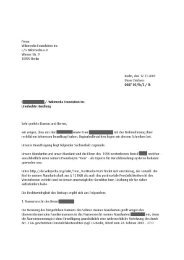Proceedings
Proceedings
Proceedings
You also want an ePaper? Increase the reach of your titles
YUMPU automatically turns print PDFs into web optimized ePapers that Google loves.
ANONYMOUS DATABROADCASTING BY SATELLITE ISPS<br />
Sender and Server The prototype of our sender first prepares the file the<br />
user wants to broadcast. Preparation involves splitting the file into chunks of<br />
constant size and encrypting each chunk. For encryption we use the Bouncy<br />
Castle crypto package [10], which offers a large variety of crypto algorithms.<br />
In particular, our prototype uses symmetric AES encryption, which may also<br />
serve as an invisible implicit address. For the first prototype we decided to<br />
add an explicit address, because it allows receivers to filter more efficiently<br />
(see below). 4 Key management is currently not implemented, i. e., we require<br />
that the sender and the receivers have exchanged a key beforehand.<br />
Using standard HTTP(S), the sender uploads the encrypted chunks to<br />
the server (Fig. 1, step 1). For the upload functionality and sender GUI<br />
we extended the Winie network utility. This tool has been developed by<br />
W3C and is tailored to putting, getting and deleting files on a Jigsaw web<br />
server using the Jigsaw client side API [11]. The server is implemented<br />
on top of the W3C open source Jigsaw web server platform. We selected<br />
Jigsaw because it is lightweight, completely implemented in Java and has a<br />
modular architecture. The latter makes it very easy to extend the server’s<br />
functionality: Using its HeaderFilter-class we can easily add the specific<br />
receiver ID to the HTTP-header.<br />
After successful upload, indicated by a positive acknowledgement, the<br />
user can initiate the broadcast of his data. When the user clicks the start<br />
broadcast-button the sender software initiates the broadcast by sending a<br />
HTTP-request for his uploaded packets to its local proxy (Fig. 1, step 2),<br />
which forwards it to the ISP proxy via the dial-up connection (Fig. 1, step<br />
3). The proxy of the ISP forwards the request to the server (Fig. 1, step<br />
4). When the server receives the HTTP-request it answers by sending the<br />
requested packets to the ISP’s proxy (Fig. 1, step 5). Now the satellite ISP<br />
forwards these packets to the satellite (Fig. 1, step 5), which broadcasts<br />
these packets encapsulated in a DVB stream (Fig. 1, step 7).<br />
Receiver The receiver prototype uses the jpcap class package to capture<br />
IP packets from the DVB network interface, as provided by the tool dvbnet.<br />
Using this package the receiver software filters the IP packets being received<br />
on the DVB network interface by the IDs associated with the receiver. Captured<br />
packets are decrypted and temporarily stored. When all chunks have<br />
been received, they are joined again, which yields the complete file.<br />
4 Conclusion and Future Directions<br />
In this paper we proposed a practical way to achieve low-cost satellite broadcasts<br />
by misusing a satellite ISP. A first proof-of-concept prototype implementation<br />
was presented. Possible applications include file sharing, Internet<br />
radio or instant messaging.<br />
4<br />
The price we have to pay for this is that broadcasts to the same group of receivers<br />
become linkable.<br />
43 |






